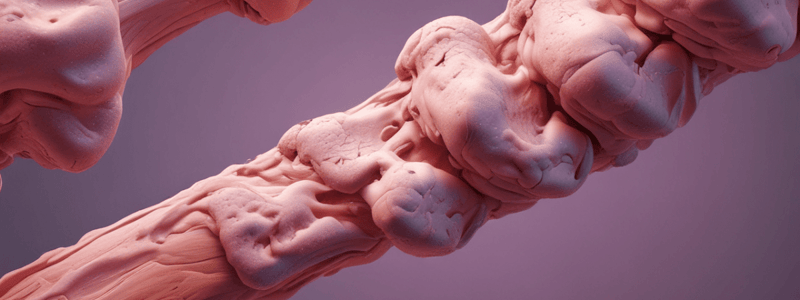Podcast
Questions and Answers
Which of the following joints are most commonly affected in peripheral arthritis associated with inflammatory bowel disease (IBD)?
Which of the following joints are most commonly affected in peripheral arthritis associated with inflammatory bowel disease (IBD)?
- Interphalangeal joints of the fingers
- Metatarsophalangeal joints of the feet
- Small joints of the hands
- Knees, hips, and shoulders (correct)
Which of the following statements about axial arthritis in IBD is NOT true?
Which of the following statements about axial arthritis in IBD is NOT true?
- It is independent of gastrointestinal symptoms
- It is characterized by sacroiliitis and spondylitis
- It is exacerbated by prolonged sitting or standing
- The onset is typically sudden and severe (correct)
Which of the following extraintestinal manifestations is NOT commonly associated with inflammatory bowel disease?
Which of the following extraintestinal manifestations is NOT commonly associated with inflammatory bowel disease?
- Uveitis
- Pyoderma gangrenosum
- Erythema nodosum
- Rheumatoid nodules (correct)
Which of the following statements about the relationship between peripheral arthritis and bowel activity in IBD is correct?
Which of the following statements about the relationship between peripheral arthritis and bowel activity in IBD is correct?
Which of the following joints is most commonly affected by enthesitis in patients with inflammatory bowel disease?
Which of the following joints is most commonly affected by enthesitis in patients with inflammatory bowel disease?
Which of the following is a characteristic extraarticular manifestation of rheumatoid arthritis?
Which of the following is a characteristic extraarticular manifestation of rheumatoid arthritis?
Which of the following is a characteristic joint deformity associated with rheumatoid arthritis?
Which of the following is a characteristic joint deformity associated with rheumatoid arthritis?
Which of the following is a specific serological marker for rheumatoid arthritis?
Which of the following is a specific serological marker for rheumatoid arthritis?
Which of the following is NOT a characteristic morphologic alteration in the joints of patients with rheumatoid arthritis?
Which of the following is NOT a characteristic morphologic alteration in the joints of patients with rheumatoid arthritis?
Which of the following is a potential cardiovascular manifestation of rheumatoid arthritis?
Which of the following is a potential cardiovascular manifestation of rheumatoid arthritis?
Which of the following is NOT a characteristic feature of rheumatoid nodules?
Which of the following is NOT a characteristic feature of rheumatoid nodules?
What is the pathway of synovial macrophage to osteoclast in the context of osteoarthritis?
What is the pathway of synovial macrophage to osteoclast in the context of osteoarthritis?
Which of the following is NOT a characteristic of Gout?
Which of the following is NOT a characteristic of Gout?
What condition is characterized by calcification of fibrous and hyaline cartilage resulting in acute pain and swelling in large joints?
What condition is characterized by calcification of fibrous and hyaline cartilage resulting in acute pain and swelling in large joints?
Which condition is associated with weakly positively birefringent rhomboid crystals in joint aspirate under polarized light?
Which condition is associated with weakly positively birefringent rhomboid crystals in joint aspirate under polarized light?
What is the primary cause of secondary gout?
What is the primary cause of secondary gout?
Which statement best describes the pathogenesis of tophi formation in gout?
Which statement best describes the pathogenesis of tophi formation in gout?
What inflammatory arthritis is mainly transmitted via direct inoculation, spread from adjacent infection, or hematogenous spread?
What inflammatory arthritis is mainly transmitted via direct inoculation, spread from adjacent infection, or hematogenous spread?
What is a feature that differentiates pseudogout from gout in terms of joint inflammation?
What is a feature that differentiates pseudogout from gout in terms of joint inflammation?
What is the most common cause of septic arthritis in older adults?
What is the most common cause of septic arthritis in older adults?
Anti-RBC antibodies are an example of Type II hypersensitivity reactions.
Anti-RBC antibodies are an example of Type II hypersensitivity reactions.
In Type III hypersensitivity, immune complexes are deposited in tissues such as the lungs and skin.
In Type III hypersensitivity, immune complexes are deposited in tissues such as the lungs and skin.
Antinuclear antibodies (ANAs) can target histones and nucleolar antigens in addition to DNA and non-histone proteins bound to RNA.
Antinuclear antibodies (ANAs) can target histones and nucleolar antigens in addition to DNA and non-histone proteins bound to RNA.
The detection of ANAs is typically done through direct immunofluorescence techniques.
The detection of ANAs is typically done through direct immunofluorescence techniques.
The presence of anti-Smith antibodies is highly specific for systemic lupus erythematosus (SLE).
The presence of anti-Smith antibodies is highly specific for systemic lupus erythematosus (SLE).
Anti-dsDNA antibodies are present in more than 95% of patients with systemic lupus erythematosus (SLE).
Anti-dsDNA antibodies are present in more than 95% of patients with systemic lupus erythematosus (SLE).
Systemic sclerosis is always associated with a positive antinuclear antibody (ANA) test.
Systemic sclerosis is always associated with a positive antinuclear antibody (ANA) test.
A speckled ANA pattern is associated with anti-Scl-70 antibodies in systemic sclerosis.
A speckled ANA pattern is associated with anti-Scl-70 antibodies in systemic sclerosis.
A centromere ANA pattern is associated with the limited cutaneous subtype of systemic sclerosis.
A centromere ANA pattern is associated with the limited cutaneous subtype of systemic sclerosis.
A nucleolar ANA pattern is specific for systemic sclerosis and is not seen in other autoimmune conditions.
A nucleolar ANA pattern is specific for systemic sclerosis and is not seen in other autoimmune conditions.
Raynaud's phenomenon is always a secondary condition caused by an underlying disease.
Raynaud's phenomenon is always a secondary condition caused by an underlying disease.
Nailfold capillaroscopy is a useful diagnostic tool to differentiate between primary and secondary Raynaud's phenomenon.
Nailfold capillaroscopy is a useful diagnostic tool to differentiate between primary and secondary Raynaud's phenomenon.
The homogeneous ANA pattern is associated with antibodies to chromatin or histones.
The homogeneous ANA pattern is associated with antibodies to chromatin or histones.
The speckled ANA pattern is considered non-specific and can be seen in various autoimmune diseases.
The speckled ANA pattern is considered non-specific and can be seen in various autoimmune diseases.
The nucleolar ANA pattern is associated with antibodies against DNA.
The nucleolar ANA pattern is associated with antibodies against DNA.
The presence of any ANA pattern is diagnostic of systemic lupus erythematosus (SLE).
The presence of any ANA pattern is diagnostic of systemic lupus erythematosus (SLE).
The rim ANA pattern is caused by antibodies binding to the nuclear membrane.
The rim ANA pattern is caused by antibodies binding to the nuclear membrane.
The homogeneous and speckled ANA patterns are mutually exclusive and cannot occur simultaneously.
The homogeneous and speckled ANA patterns are mutually exclusive and cannot occur simultaneously.
Flashcards are hidden until you start studying




